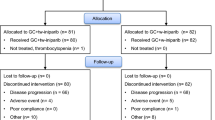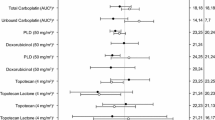Summary
Monoclonal antibodies are capable of modulating drug metabolising enzymes resulting in unexpected plasma concentrations of a drug when given concomitantly. Therefore plasma concentration of paclitaxel (PTX) and its metabolites has been monitored in 10 patients with advanced breast cancer during treatment with PTX alone or combined with trastuzumab (TMAB, paired cross over design). Compared to the MONO regimen PTX peak plasma concentrations were about 25 % lower in the TMAB schedule: cmax=3294 ± 1174 ng/ml (MONO: 4368 ± 1887 ng/ml). TMAB also caused lower peak plasma concentration of the main metabolite 6-hydroxy PTX (248 ± 89 ng/ml) compared to the MONO schedule (194 ± 82 ng/ml). Cmax of the minor metabolites was distinctly below 100 ng/ml and consequently differed negligible in both schedules. The similar apparent formation rate of the metabolites in both schedules (range from 30 to 50 min) as well as identical tmax values (range 170–190 min) suggested that TMAB had no influence on PTX metabolism. In accordance to plasma concentrations, AUClast of PTX was lower in the MONO schedule (733 ± 197 μg/ml*min, AUClast=669 ± 248 μg/ml*min for TMAB) but without significance. In summary no indices for an altered plasma disposition of PTX and its metabolites could be found when TMAB was given concomitantly.
Similar content being viewed by others
References
Winer E.P., Burstein H.J. (2001): New combinations with Herceptin in metastatic breast cancer. Oncology 61, 50–57
Merlin J.L., Barberi-Heyob M., Bachmann N. (2002): In-vitro comparative evaluation of trastuzumab (Hercerptin®) combined with paclitaxel (Taxol®) or docetaxel (Taxotere®) in HER2-expressing human breast cancer cell lines. Ann. Oncol. 13, 1743–48
Hortobagy G.N. (2000): Developments in chemotherapy of breast cancer. Cancer 88,3073–3079
Esteva F.J., Valero V., Pusztai L., Boehnke-Michaud L., Buzdar A.U., Hortobagy G.N. (2001): Chemotherapy of metastatic breast cancer: what to expect in 2001 and beyond. Oncologist 6, 133–146
Shak S. (1999): Overview of the trastuzumab (Herceptin®) anti-HER2 monoclonal antibody clinical program in HER2-overexpressing metastatic breast cancer. Herceptin Multinational Investigator Study Group. Semin. Oncol. 26, 71–77
Weiner L.M. (1999): An overview of monoclonal antibody therapy in cancer. Semin. Oncol. 26, 41–50
Goldenberg M.M. (1999): Trastuzumab, a recombinant DNA-derived humanized monoclonal antibody, a novel agent for the treatment of metastatic breast cancer. Clin. Ther. 21, 309–318
Hortobagy G.N. (2001): Overview of treatment results with trastuzumab (Herceptin) in metastatic breast cancer. Semin. Oncol. 28, 43–47
Seidman A.D., Fornier M.N. Esteva F.J. (2001): Weekly trastuzumab and paclitaxel therapy for metastatic breast cancer with analysis of efficacy by HER2 immunophenotype and gene amplification. J. Clin. Oncol. 19, 2587–95
O’Shaughnessy J. (2003): Gemcitabine and trastuzumab in metastatic breast cancer. Semin. Oncol. 30, 22–26
Ligibel J.A., Winer E.P. (2002): Trastuzumab / chemotherapy combinations in metastatic breast cancer. Sem. Oncol. 29, 38–43
Gori S., Colozza M., Mosconi A.M., Franceschi E., Basurto C, Sidoni A., Rulli A., Bisacci C, De Angelis V., Crino L. Tonato M. (2004): Phase II study of weekly paclitaxel and trastuzumab in anthracycline- and taxane pretreated patients with HER2-overexpressing metastatic breast cancer. Br. J. Cancer 90, 36–40
Cresteil T., Monsarrat B., Alvinerie P. (1994): Taxol metabolism by human hepatic microsomes: identification of cytochrome P450 isoenzymes involved in its biotransformation. Cancer Res. 54, 386–392
Karlsson M.O., Molnar V., Freijs A., Nygren P., Bergh J. Rolf L.A. (1999): Pharmacokinetic models for the saturable distribution of paclitaxel. Drug Metab. Disp. 27, 1220–23
Kearns C.M. (1997): Pharmacokinetics of Taxanes. Pharmacotherapy 17, 105–109
Gelboin H.V., Krausz K.W., Shou M., Gonzalez F.J. Yang T.J. (1997): A monoclonal antibody inhibitory to human P450 2D6: Paradigm for use in combinatorial determination of individual P450 role in specific drug tissue metabolism. Pharmacogenetics 7, 469–477
Krausz K.W., Goldfarb I., Buters J.T.M., Yang T.J., Gonzalez F.J., Gelboin H.V. (2001): Monoclonal antibodies specific and inhibitory to human cytochromes P450 2C8,2C9 and 2C19. Drug Metab. Dispos. 29, 1410–1423
Schmider J., Greenblatt D.J., von Moltke L.L., Harmatz J.S., Duan S.X., Karsov D., Shader R.I. (1996): Characterization of six in-virro reactions mediated by human cytochrome P450: application to the testing of cytochrome P450 directed antibodies. Pharmacology 52, 125–134
Shu L., Hollenberg P.F. (1996): Identification of the cytochrome P450 isoenzymes involved in the metabolism of N-nitrosodipropyl-, N-nitrosodibutyl- and N-nitroso-N-butyl-N-propylamine. Carcinogenesis 17, 839–848
Czejka M.J., Schueller J., Schnait H., Springer B. Eder I. (2003): Clinical pharmacokinetics and metabolism of paclitaxel after 3-hour infusion: comparison of two preparations. J. Oncol. Pharm. Pract. 9, 127–136
Harris K.A., Washington C.B., Lieberman G., Lu J.F., Mass R., Bruno R. (2002): A population pharmacokinetic model for trastuzumab (Herceptin®) and implications for clinical dosing. Proc. ASCO, Abstract No. 488
Gelmon K., Arnold A., Verma S., Ayoub J.P., Hemmings F., Layland-Jones B. (2001): Pharmacokinetics and safety of trastuzumab (Herceptin®) when administered every three weeks to women with metastatic breast cancer. Proc. ASCO, Abstract No. 271
Strehlau J., Pape L., Offner G., Nashan B., Ehrich J.H, (2000): Interleukin-2 receptor antibody induced alterations of Ciclosporin dose requirements in paediatric transplant recipients. Lancet 356, 1327–132
Leyland-Jones B., Gelmon K., Ayoub J.P., Arnold A., Verma S., Dias R., Grahamani P. (2003): Pharmacokinetics, safety, and efficacy of trastuzumab administered every three weeks in combination with paclitaxel. J. Clin. Oncol. 21, 3965–71
Author information
Authors and Affiliations
Rights and permissions
About this article
Cite this article
Furtlehner, A., Schueller, J., Jarisch, I. et al. Disposition of paclitaxel (Taxol®) and its metabolites in patients with advanced breast cancer (ABC) when combined with trastuzumab (Hercpetin®). European Journal of Drug Metabolism and Pharmacokinetics 30, 145–150 (2005). https://doi.org/10.1007/BF03190613
Received:
Issue Date:
DOI: https://doi.org/10.1007/BF03190613




